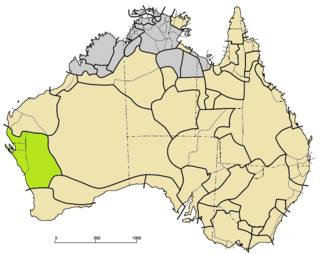Related Research Articles
Panyjima is an Australian Aboriginal language spoken in the Hamersley Range, in the Pilbara region of Western Australia. It is the traditional language of the Panyjima people. The name has also been spelled Bandjima, Banjima, Banyjima, Paanjima, Pandjima, Panjima, Panjtjima, and Panytyima.

The Kartu languages is a group of Indigenous Australian languages spoken in the Murchison and Gascoyne regions of Western Australia. They are thought to be closely related and to form a low-level genealogical group.
Kurrama is an Australian Aboriginal language. It is a dialect of Yindjibarndi, one of the Ngayarda languages of the large Pama–Nyungan family, with almost identical vocabulary and grammar, but speakers consider it to be a distinct language.

The Worrorran (Wororan) languages are a small family of Australian Aboriginal languages spoken in northern Western Australia.

The Jarrakanlanguages are a small family of Australian Aboriginal languages spoken in northern Australia. The name is derived from the word jarrak, which means "language" in Kija.

The Bunuban languages are a small family of Australian Aboriginal languages spoken in northern Australia. The family consists of two languages, Bunuba and Gooniyandi, which are related to each other to about the same degree that English is related to Dutch. Bunuba has about 100 speakers and Gooniyandi about 400. Both are endangered.
Garadjari is an Australian Aboriginal language spoken by the Karajarri people.
The Ngarinyin language (Ungarinjin), or Eastern Worrorran, is a moribund Australian Aboriginal language of Western Australia. With less than one hundred living speakers, Ngarinyin is considered a critically endangered language, though there are efforts being made to documenting speech and grammar structures before it becomes extinct, including the specifics on the terms of the kinship system of the language.
Broome Pearling Lugger Pidgin is a pidgin that sprang up in Broome, Western Australia in the early 20th century to facilitate communication between the various groups working in the pearling industry there—Japanese, Malays, Torres Strait Islanders, Koepangers, Hakka Chinese, Filipinos, a small number of Koreans, and local Indigenous Australians, mainly of the Bardi people but also Nyulnyul, Jabirr Jabirr, Jukun, Yawuru and Karajarri people.
Doolboong is an extinct Australian Aboriginal language formerly spoken by the Doolboong on the coast of the Cambridge Gulf in the Northern Territory.
Gooniyandi is an Australian Aboriginal language now spoken by about 100 people, most of whom live in or near Fitzroy Crossing in Western Australia. Gooniyandi is an endangered language as it is not being passed on to children, who instead grow up speaking Kriol.
Kija is an Australian Aboriginal language today spoken by about 100 people, most of whom live in the region from Halls Creek to Kununurra and west to Lansdowne and Tableland Stations in Western Australia. It is a member of the Jarragan language family, a non-Pama-Nyungan family in the East Kimberleys. The Argyle Diamond Mine, on the south western corner of Lake Argyle is on the borders of Gija and Miriwoong country. The Purnululu Bungle Bungle National Park is mostly in Gija country.
Kugu-Muminh (Wik-Muminh), also known as Kugu- or Wik-Nganhcara (Wikngenchera), is a Paman language spoken on the Cape York Peninsula of Queensland, Australia, by several of the Wik peoples. There are multiple dialects, only two of which are still spoken: Kugu-Muminh itself, and Kugu-Uwanh.
Jurruru is an extinct Australian Aboriginal language formerly spoken in the Pilbara region of Western Australia. Its name has also been spelt Chooraroo, Choororoo, Churoro, Djuroro, Djururo, Djurruru, Dyururu, Jururu, Thuraru, Tjororo, Tjuroro, Tjururo, and Tjururu.
Mudbura (Mudburra), also known as Pinkangama, is an aboriginal language of Australia.

Worrorra (Worora), or Western Worrorran, is a moribund Australian Aboriginal language of northern Western Australia.
Ngarluma and Kariyarra are members of a dialect continuum, which is a part of the Ngayarda language group of Western Australia, in the Pama–Nyungan language family. Some sources suggest that an extinct dialect, Jaburara, was a third member of the continuum. However, it is clear that Jaburara had a distinct identity that has been partly obscured by a collapse in the numbers of Jaburara speakers during the late 19th century, and there is some evidence that Jaburara may have instead been a dialect of Martuthunira.
Ngarigo (Ngarigu) is a nearly extinct Australian Aboriginal language, the traditional language of the Ngarigo people.
Djaru (Tjaru) is a Pama–Nyungan language spoken in the Kimberley region of Western Australia.
The Gadjerong are an indigenous Australian people of the Northern Territory, most of whom now live in northeastern Western Australia.
References
- 1 2 K37.1 Gajirrabeng at the Australian Indigenous Languages Database, Australian Institute of Aboriginal and Torres Strait Islander Studies
- ↑ Hammarström, Harald; Forkel, Robert; Haspelmath, Martin, eds. (2017). "Gajirrabeng". Glottolog 3.0 . Jena, Germany: Max Planck Institute for the Science of Human History.
- ↑ "Language: Gajirrabeng". World Loanword Database. Max Planck Society. Retrieved 10 February 2020.
- McGregor, William (2004). The Languages of the Kimberley, Western Australia. London, New York: Taylor & Francis.
| This Australian Aboriginal languages-related article is a stub. You can help Wikipedia by expanding it. |